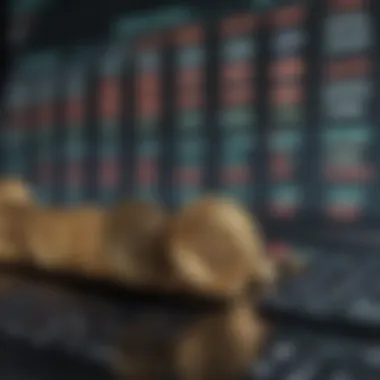Understanding the Role of Crypto Ticker Displays


Intro
In the fast-paced world of cryptocurrency trading, information is key. The ability to access real-time market data can be the difference between profit and loss. Crypto ticker displays serve as the pulse of the digital currency market, vividly illustrating current prices, trading volume, and market trends. These displays are not merely decorative; they are essential tools for investors and traders alike, enabling informed decision-making at the click of a button.
Going beyond just being aesthetics, crypto tickers reflect the very volatility and dynamism of the markets they represent. Each tick and flash brings live updates that can influence trading strategies, market sentiment, and ultimately, the bottom line for traders. As we dive deeper into the mechanics of these displays, it becomes imperative to grasp their underlying importance and functionality.
The significance of these tools can’t be overstated. In a world where market conditions can shift drastically in mere seconds, having a reliable and accessible source of information integrates smoothly with trading platforms, enhances user experience, and shapes the decisions of even the most seasoned investors.
Without further ado, let’s explore the market landscape of cryptocurrency and how these ticker displays are interwoven into its fabric.
Understanding Crypto Ticker Displays
In the fast-paced world of cryptocurrency, having the right tools at one's disposal can be a deciding factor in trading success. Crypto ticker displays serve as essential instruments in this environment, offering users near-instantaneous updates on the market. These displays are not just mere graphics on a screen; they encapsulate the pulse of the market, providing insights that can inform decisions.
For both novice investors and seasoned traders, grasping the mechanics behind crypto ticker displays is crucial. They assist users in monitoring multiple assets simultaneously, presenting data on price changes, trading volumes, and market capitalizations. Consequently, a solid understanding of these ticker displays empowers individuals to make more informed decisions, reducing the risk of losses born from delayed or inaccurate information.
The digital finance landscape is riddled with complexity, and keeping track of real-time data is fundamental. This is where the purpose and functionality of crypto ticker displays become evident.
Definition of Crypto Ticker Displays
A crypto ticker display is essentially a digital interface that showcases real-time cryptocurrency market data. It constantly refreshes, enabling traders and investors to stay updated with the latest prices and trading volumes of various cryptocurrencies. Some may liken it to a scoreboard in a sports game – it's where one looks to gauge who's winning and by how much.
These tickers can be found in various formats: on websites, integrated within trading platforms, and even in mobile applications. They can showcase not just the current price – frequently presented alongside symbols or abbreviations for each cryptocurrency – but also a range of other pertinent metrics. Examples include price fluctuations over different time frames, changes in trading volume, and trends in market cap, all of which are instrumental for decision-making.
Purpose and Importance
The purpose of crypto ticker displays is clear: to provide traders and investors with timely and relevant information. In an arena where every second counts, having access to up-to-the-minute data can mean the difference between profit and loss. The importance of these displays is manifold:
- Real-time updates: Crypto markets operate 24/7, and prices are not static. The ability to observe real-time fluctuations is vital for making strategic decisions.
- Enhanced decision-making: Having immediate access to crucial information helps traders react more swiftly to market changes, which can optimize profits and minimize losses.
- Market insight: By keeping an eye on various cryptocurrencies simultaneously, individuals can discern patterns, volatility, and capital flows, enriching their understanding of market dynamics.
"Crypto ticker displays are the lifeblood of informed trading – without them, one might as well be trading with their eyes closed."
Core Components of a Crypto Ticker
Understanding the core components of a crypto ticker is crucial for investors, traders, and anyone vested in the cryptocurrency sphere. A crypto ticker is not merely a digital band that displays numbers; it’s a tool packed with information that shapes trading strategies and market positions. When one digs deeper into what makes up these displays, several key elements emerge that hold significant weight in their functionality.
Price Data
At the heart of any crypto ticker is price data. This is the lifeblood of trading; essentially, it reflects the current value of cryptocurrencies against fiat currencies like the US dollar or against other cryptocurrencies. The ticker shows real-time prices which are crucial during periods of high volatility typical in the crypto markets. Here’s why it matters:
- Market Movement: Traders rely on price data to make instant buying or selling decisions. Even a minute’s delay can lead to losses or missed opportunities.
- Understanding Trends: The historical price movement can be analyzed to identify patterns. Investors often look for buy signals in price fluctuations.
Price data isn’t just numbers on a screen; it paints a picture of market health and investor sentiment, guiding strategic decisions in investment.
Trading Volume
Another pivotal component is trading volume. This metric illustrates how many units of a specific cryptocurrency have been traded within a given time frame, typically over 24 hours. The impacts of trading volume are manifold:
- Liquidity Insight: High trading volumes often indicate good liquidity, which means that traders can buy or sell crypto assets without affecting the price significantly. This is crucial for reducing transaction costs.
- Market Sentiment Indication: A sudden spike in volume may signal strong interest or a significant shift in market dynamics, often preceding important price movements. Traders use this data to gauge market enthusiasm or caution.
Understanding trading volume is essential as it combines with price data to offer insights into the strength behind price movements.
Market Capitalization
The last critical component at this level is market capitalization. Market cap is calculated by multiplying the cryptocurrency's price by its circulating supply. This metric serves as a barometer for overall market value and health. Here are some implications:
- Comparison Standard: Market cap allows investors to compare the relative size of various cryptocurrencies. This can help in allocating investments based on risk assessment and potential returns.
- Market Stability Indicator: Generally, higher market caps suggest more established cryptocurrencies, often leading to less volatility than smaller, lesser-known coins. Newer coins might promise high returns, but they can also bring higher risks.
In conjunction, these three components form the backbone of crypto tickers, providing the essential data that influences trading decisions. The interplay between price data, trading volume, and market capitalization offers a comprehensive view of the market, shaping the strategies that savvy investors and traders employ daily.
Understanding these core components isn't just advantageous; it's fundamental to navigating the crypto markets efficiently.
Such elements underline the importance of having a well-rounded view of bitcoin and altcoin movements, ensuring that one remains agile and informed in an environment as dynamic as cryptocurrency.


Types of Crypto Ticker Displays
The types of crypto ticker displays play a pivotal role in how traders and investors assimilate information on digital assets. Each type has its unique characteristics and benefits. Their varying formats cater to different preferences and usage scenarios, making it essential to understand the nuances behind web-based, mobile app, and desktop software tickers. This knowledge allows investors and traders to choose the most suitable option for their needs, ensuring they stay informed and make timely decisions in the fast-paced crypto market.
Web-Based Tickers
Web-based tickers are quite popular among regular users who want to keep track of crypto prices without downloading software. Accessible via browsers, these tickers often provide real-time updates. Beyond just showing prices, they may present related metrics such as trading volume and market cap, all in a clean, straightforward layout.
- These tickers often allow users to customize their views, showing only the information they deem crucial.
- They're typically free to use, making them widely accessible.
- Many web-based options integrate interactive charts for deeper analysis.
However, it’s important to note their reliance on internet connectivity. If your connection falters, you risk missing important price movements. Users often emphasize clarity and speed in these displays, as time is money in trading.
Mobile App Tickers
Mobile app tickers cater to on-the-go traders. With smartphones so integrated into daily life, having price information at one's fingertips can make all the difference.
What makes mobile app tickers stand out?
- Push Notifications: Users receive alerts for major price changes, helping them seize opportunities promptly.
- User-Friendly Design: These apps often feature intuitive designs, making navigation seamless, even for beginners.
- Portable Analysis: Traders can monitor multiple assets while commuting or on breaks, ensuring they never feel out of touch.
However, these applications can, at times, experience slow updates. Users also have to be cautious regarding security, as mobile apps can be vulnerable to various threats if not properly protected.
Desktop Software Tickers
When it comes to comprehensive tracking, desktop software tickers often take the crown. These programs are designed for users who prefer a robust and detailed analysis experience.
Using desktop software tickers can be advantageous for several reasons:
- Advanced Analytics: They often come packed with features for technical analysis and customizable charts, allowing serious traders to deep-dive into market performance.
- Multiple Account Management: Users can manage several exchanges and wallets from one location, streamlining their trading strategies.
- Data Stability: Desktop applications tend to have a more stable data feed compared to their web or mobile counterparts, meaning updates appear more consistent.
Nonetheless, they may require a learning curve, especially for those new to crypto trading. The installation process can be daunting, although the payoff is often worth it for those committed to serious trading.
Integration with Trading Platforms
In the world of crypto trading, integration with trading platforms stands as a cornerstone for efficient trading experiences. The importance of seamless connectivity between crypto tickers and trading systems cannot be overstated. This integration serves not only the traders but also the theoretical underpinnings of market functionality. By ensuring ease of access to real-time data, such integrations empower traders can make decisions backed by the latest market movements.
Direct API Integrations
Direct API integrations form the backbone of interactions between crypto ticker displays and trading platforms. APIs, or Application Programming Interfaces, allow different software programs to communicate with each other. In practical terms, it means that when a trader uses a ticker display, the data shown is fed directly from trading platforms through APIs.
Some advantages of direct API integrations include:
- Real-Time Sharing of Data: As market prices change, this integration enables immediate updates on price movements, trading volumes, and more, which is crucial for making informed trading decisions.
- Personalization: APIs often allow custom settings, enabling users to receive tailored information that suit their trading strategies. This means traders can focus on specific coins or price ranges that align with their investment vision.
- Streamlined Workflow: By connecting with trading platforms, the process of executing trades becomes more efficient. This reduces the time spent toggling between multiple interfaces or platforms, making the trading process smoother and faster.
User Interface Considerations
While the technical aspects of integration are critical, the user interface plays a vital role as well. The effectiveness of a crypto ticker ultimately hinges on how well it presents information to the user, and this is where good design meets usability.
When considering user interface design for crypto tickers, several factors come into play:
- Clarity and Simplicity: A clean, intuitive design can drastically enhance user experience. Complicated layouts can overwhelm users, particularly new traders, making it difficult for them to navigate timely information needed for trading decisions.
- Responsiveness: In today’s fast-paced trading environment, users often switch between devices, whether it be a smartphone, tablet, or desktop. Ensuring that the interface remains functional and appealing across different platforms is essential.
- Visual Hierarchy: The arrangement of information on a ticker should be intentional. Highlighting key data such as real-time prices and graphs with color coding can aid users in quickly grasping necessary changes in the market.
"A good interface is like a well-organized toolbox; it helps you search, find, and use the right tools effectively."
In summation, integration with trading platforms enhances the value of crypto tickers significantly. Direct API connections and well-designed user interfaces are indispensable for facilitating a smooth, efficient trading experience. They not only boost trader engagement but also promote better decision-making in a high-stakes environment.
Real-Time Data Accessibility
In the fast-paced world of cryptocurrency, the relevance of real-time data accessibility cannot be overstated. Successful trading often boils down to the minute-by-minute updates that inform traders and investors of market movements and price fluctuations. When every second counts, having reliable and immediate data can make the difference between profit and loss.
Importance of Latency
Latency refers to the delay between data transmission and reception. In the context of crypto ticker displays, low latency is crucial. If a ticker updates its prices every few seconds instead of milliseconds, traders may find themselves acting on outdated information. This could lead to missed opportunities or—worse—financial losses. Traders who rely on split-second decisions need tickers that provide instantaneous updates.
Various factors can influence latency, including:


- Network conditions: A slow internet connection can hinder data refresh rates.
- Server efficiency: The infrastructure supporting data distribution plays a significant role in how quickly info can be relayed to users.
- Geographical location: For traders located far from data centers, there might be inherent lags in the information flow.
Sources of Data Aggregation
Crypto ticker displays pull information from a variety of sources. A well-aggregated ticker draws upon multiple exchanges, ensuring that the displayed prices reflect a broader market context. Relying on just one exchange can lead to skewed results, given that price variances might occur among different platforms.
Key sources of data include:
- Cryptocurrency Exchanges: Major exchanges like Binance, Coinbase, and Kraken provide primary feeds of market data. Each of these platforms may showcase different prices for the same asset, depending on their trading activities.
- Market Data Providers: Companies such as CoinGecko and CoinMarketCap aggregate information across multiple exchanges, offering a comprehensive overview of market conditions.
- User-Generated Data: Some tickers incorporate data from community platforms like Reddit, where traders share real-time insights and sentiments.
Utilizing a blend of these sources can ensure that traders have access to the most accurate and timely data, thereby enhancing their decision-making capability in an often volatile market. As crypto assets continue to shift, the integrity and timeliness of real-time data will critically shape trading strategies.
"In a market that fluctuates at the speed of light, being ill-informed is a risk that no trader can afford to take."
Adapting to these realities of real-time data accessibility not only demonstrates an understanding of the current trading environment but also positions traders to navigate challenges effectively, leading to more informed and strategic choices in their investment journeys.
User Experience in Crypto Trading
The manner in which users interact with a crypto ticker display can greatly influence their trading decisions. In this fiercely competitive arena, where milliseconds can make or break a trade, ensuring optimal user experience becomes a pivotal focus. Every design choice, each feature, and how information is presented matters significantly. A clean layout, intuitive navigation, and timely information flow can vastly improve decision-making. Conversely, a cluttered screen can lead to confusion and missed opportunities.
Evaluating user experience begins by examining how effectively the design caters to the needs of traders. These users often work under pressure, so their chosen tools must streamline the process, rather than complicate it. Functional design is necessary for every aspect of the ticker display, from its visual components to the user interface. Layout and organization must prioritize the most relevant information, such as current pricing and volume metrics, making accessibility a breeze.
A well-designed interface bridges the gap between complex data and user understanding, driving smarter trading decisions.
Effects of Design and Layout
The layout is the first element that traders notice. A well-structured interface can significantly enhance comprehension of the data presented. For instance, a display that separates different cryptocurrencies with clear headers and aligns price changes using color cues can swiftly convey critical information.
Factors to consider in design and layout include:
- Clarity: Information must be easy to read. Text should contrast with the background, and graphics should not be overwhelming.
- Hierarchy: Important data should be prioritized. Price movements may grab attention faster if they are visually prominent compared to trading volume.
- Consistency: Design elements, such as button sizes and font styles, need uniformity to avoid visual confusion. A seamless experience lets traders focus on making moves, rather than deciphering the interface.
- Responsive Design: Users might access the ticker via different devices. Ensuring the layout adapts to various screen sizes can contribute to a positive user experience.
Customization Options
Customization is another critical aspect of user experience. Traders often prefer personalized setups that meet their specific trading needs. It’s the differences in individual goals that require flexibility within a ticker’s design. A one-size-fits-all solution may overlook unique strategies and preferences.
The ability to tailor displays can take many forms:
- Widget Arrangement: Allowing traders to drag and drop various ticker elements lets them create a layout that reflects their priorities.
- Alert Systems: Users can set notifications for specific price points or trading volumes, ensuring they never miss critical information.
- Theme Options: Traders may prefer dark mode over light mode for visibility in low-light conditions, or vice versa. Providing options can enhance comfort and reduce strain during long trading sessions.
- Information Filters: Enabling users to filter out currencies, price ranges, or timeframe data can help them focus on what they deem most relevant.
The Role of Color and Visualization
In the fast-paced world of cryptocurrency trading, color and visualization play a pivotal role in how traders digest information. The palette and graphical elements used in a crypto ticker display can make the difference between quickly grasping market movements or getting lost in a sea of numbers.
Visual cues like color coding not only grab attention but also provide immediate context. For traders who live on the edge of decision-making, these elements help to convey vital information at a glance. Imagine looking at a screen filled with green lights against a backdrop of red – it’s not just eye candy but a language of its own that speaks volumes about market sentiment.
When utilized effectively, color and visualization can enhance the understanding of complex data, making it more accessible to investors and analysts alike. They simplify intricate data sets to depict price movements and trends, providing crucial insights that can shape trading strategies. Thus, the dynamics of color and visualization stand at the forefront of effective market analysis.
Color Coding for Price Movement
Color coding is perhaps the most recognized aspect of visualization in crypto tickers. It often uses familiar colors: green for gains, red for losses. This universal signal resonates well with traders who require immediate clarity on price shifts without wading through numbers. Furthermore, the implementation of yellow or orange can signal caution, indicating where prices might be volatile or nearing important thresholds.
- Immediate Recognition: Traders can immediately see whether an asset is trending up or down.
- Emotions Translated: Colors evoke emotional responses, allowing traders to momentarily step back and evaluate their feelings towards their holdings.
- Quick Analysis: In high-pressure environments, this quick visual feedback can determine whether to hold, buy, or sell.
This system of color coding helps foster an intuitive understanding of market conditions. However, care must be taken to consider how color blindness might affect some traders, and ensuring accessibility is crucial. Developers are increasingly utilizing algorithms that account for various visual impairments to maintain inclusivity in the trading experience.
Graphical Representations
Graphical representations add another layer of complexity and utility to crypto ticker displays. They transform raw data into visual forms, such as line charts, candlestick patterns, or bar graphs, which illustrate trends over time. Each representation lends itself to different interpretative methods and insights:
- Line Charts illustrate price trends clearly over specified timeframes, helping traders discern long-term movements.
- Candlestick Patterns provide a wealth of information about market behavior within specific time frames, indicating potential reversals or continuation patterns based on the opening, closing, high, and low prices.
- Bar Graphs can depict trading volume and price variances, supporting a quick visual assessment of market activity.
Using these graphical tools, traders can collaborate their insights by identifying patterns and signaling potential trading opportunities. The real power lies in their ability to present a large amount of data succinctly while allowing traders to engage in deeper technical analysis based on what they observe.
"In business, it is not the strongest or the most intelligent who will survive but those who can best manage change." - Charles Darwin


Overall, the strategic use of color and visualization in crypto ticker displays cannot be overlooked. They are not mere embellishments but significant tools that underpin effective decision-making in the exciting yet volatile realm of cryptocurrency.
Challenges in Crypto Ticker Implementations
In the fast-paced world of cryptocurrency, where every second counts, the implementation of crypto ticker displays encounters numerous challenges. These hurdles can significantly affect the efficiency, reliability, and user trust in these systems. As such, understanding these challenges is critical as the crypto landscape continues to evolve and integrate new technologies. The ability of ticker displays to effectively serve investors, traders, and enthusiasts hinges on addressing these challenges.
Data Accuracy and Integrity
Data accuracy is paramount when it comes to crypto tickers. Traders rely on these displays for real-time information on price fluctuations, trading volumes, and market trends. Therefore, any lapse in data integrity can prove costly. If a ticker shows outdated or incorrect prices, traders may make ill-informed decisions, sometimes resulting in significant financial losses. For instance, imagine a trader monitoring a Bitcoin price ticker that accidentally latched onto a glitch, displaying prices far off market reality. Such a situation could lead to speculative actions that are based on faulty data.
Various factors contribute to accuracy challenges. The volatile nature of cryptocurrencies means that data must refresh constantly to stay relevant. Additionally, the sources from where the data is aggregated can differ significantly, leading to inconsistencies. Some tickers may compile data from various exchanges, each with its own set of prices.
To ensure data accuracy, ticker developers have to implement robust aggregation algorithms that can filter out noise and provide a clean, concise output. In essence:
- Regular audits and assessments of data sources can help verify integrity.
- Using multiple feeds and cross-referencing them can ensure consistency.
- Leveraging blockchain technology for transparent data might just be a step toward improving trust and reliability.
Overcoming User Fatigue
In today’s information-saturated world, traders and investors may suffer from what is often termed "user fatigue." This occurs when individuals are bombarded with data in a way that becomes overwhelming and leads to disengagement. With crypto tickers displaying rapid price changes, trading volumes, and other metrics all at once, navigating this flood of information can become mentally taxing.
To combat this challenge, developers have begun experimenting with various user interface elements aimed at enhancing clarity and reducing cognitive load. For example:
- Simplified Dashboards: Instead of cluttered displays filled with all possible data points, focusing on essential metrics allows users to spot key trends without feeling overwhelmed.
- Customizable Views: Enabling users to tailor their dashboards according to their specific interests can also help mitigate fatigue. This way, they can decide which data is crucial for their trading strategies.
- Alerts and Notifications: By providing push notifications or alerts for significant market movements, traders can avoid the need to constantly monitor tickers, allowing them to maintain focus and energy.
In summary, by addressing both data accuracy and user fatigue, developers can enhance user experience significantly. This not only fosters greater user trust in ticker displays but also encourages more informed trading decisions across the cryptocurrency landscape.
"A well-designed crypto ticker not only reflects the market, but it also respects the user's need for clarity and comprehension."
By navigating these challenges thoughtfully, the future of crypto ticker displays can indeed be brighter, fostering an environment where informed trading flourishes.
Future Trends in Crypto Ticker Displays
The landscape of cryptocurrency is ever-evolving, and so too are the tools that traders and investors rely on. Crypto ticker displays play a critical role in this dynamic, acting as the eyes and ears of the market. The future of these displays is not just about keeping pace; it’s about innovation and mastery over digital information. Here, we will explore significant trends that are reshaping how information is displayed and how it can be leveraged to make informed trading decisions.
Increased AI Integration
As artificial intelligence continues to weave itself into the fabric of various industries, its integration into crypto ticker displays is a natural progression. The potential benefits of AI in this context are manifold. AI can analyze massive datasets at breakneck speed, providing predictive insights and automating processes that previously took manual effort. Imagine a ticker that not only displays current prices but also predicts future movements based on historical trends and real-time data.
- Enhanced Analytics: AI can sift through news, social media sentiment, and trading patterns to identify potential market trends even before they become apparent to human analysts. This provides traders with a competitive edge.
- Smart Alerts: Tickers can utilize AI to create custom alerts based on user-defined parameters, notifying traders of significant price changes or unusual trading volumes, thus streamlining decision-making.
The blending of AI with crypto tickers stands to empower users, making complex data simpler to digest while retaining accuracy. A future where traders almost have a personal assistant guiding their decisions doesn’t seem out of reach.
"AI not only enhances the utility of crypto tickers but also transforms the trader's experience by offering deeper insights and more tailored functionalities."
Enhanced Mobile Features
The surge in mobile device usage is undeniable, and it has significant implications for crypto ticker displays. As traders increasingly rely on their smartphones for trading and monitoring markets, ticker displays are evolving to meet this demand with a more mobile-friendly approach.
- User-Centric Design: Mobile interfaces need to prioritize clear readability and quick access to critical information. Designs that incorporate larger buttons and simplified navigation can be a game changer.
- Real-Time Notifications: With the rise of mobile trading, the importance of instant notifications has sky-rocketed. Tickers should be designed to send push notifications for critical market movements, thus ensuring traders aren't tethered to their screens all day.
- Offline Functionality: Imagine accessing your last viewed data without an internet connection. The ability to store recent data can be particularly useful for users in areas with poor connectivity.
As we move forward, enhancing mobile features will be paramount for the success of crypto ticker displays. A competitive edge will undoubtedly hinge on companies’ ability to meet traders' needs in a fast-paced, mobile-centric world.
End
In summing up the importance of crypto ticker displays, it's clear these components are not just trivial elements of the trading experience; they are essential linchpins that influence decision-making processes in the fast-paced cryptocurrency environment. They provide real-time price updates and critical quantitative metrics which shape traders' strategies. Engaging with these tickers equips investors and analysts with timely data necessary for making sound investment choices.
Recap of Ticker Display Importance
The role of ticker displays in the crypto landscape cannot be understated. They serve as the main conduit through which market information flows, allowing users to observe price fluctuations, trading volumes, and other vital market dynamics.
- Timeliness: A minute can make or break a trade, and these displays offer updates that could sway decisions positively or negatively.
- User-Friendly Interfaces: With the right design, traders can easily navigate through complex data points to find information swiftly, enhancing trading efficiency.
- Accessibility: These displays break the barriers of traditional investing by enabling real-time trading from virtually anywhere, thereby democratizing access to the crypto market.
All these aspects underscore that an understanding of how crypto ticker displays function is crucial for anyone involved in cryptocurrency trading.
Final Thoughts on Evolution
As we gaze into the future, it's apparent that crypto ticker displays are on the brink of significant innovations. With technology evolving at a breakneck pace, tickers will likely become even more advanced, integrating features powered by machine learning and artificial intelligence to predict market trends and user preferences.
Additionally, the growing demand for user customization might mean traders could see personalized displays tailored not just to their strategy but also to their emotional trading state.
The commitment to improving design, enhancing accessibility, and integrating with myriad platforms will shape the evolution of these displays. The more adaptable they become, the more they will likely influence trading behavior, making them a vital focus moving forward.















